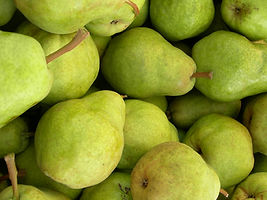Gem *Currently available for the 2025-2026 planting season!
A new fire blight-resistant variety from the U.S. Department of Agriculture’s breeding program. The pear is medium sized with light green skin that turns to yellow when ripe. The skin can have up to 35 percent red blush. It does not russet under dry growing conditions, and only occasionally in humid conditions. The variety is precocious, bearing fruit three years after planting, and produces high yields,
Bartlett *Currently available for the 2025-2026 planting season!
Leading pear for canning and fresh market sales. Large, golden yellow fruit with a slight blush. Smooth, juicy, tender white flesh. Partially self-fruitful.
Hailey Red™(c.LT1) *Currently available for the 2025-2026 planting season!
A sport of the Bartlett pear, Hailey Red is the best Red Bartlett discovered to date. It is just like the Bartlett, except it has an exceptional red color. It ripens the same time as the Bartlett. It is very juicy with white flesh. It does not need a pollinizer. Storage life is better than Bartlett, and holds red color better than other red pear varieties.
Comice *Currently available for the 2025-2026 planting season!
Large yellow fruit. Excellent dessert-quality pear. Flesh is tender with excellent flavor. Skin color is yellow with a slight blush. Best used fresh. Tree is large, upright and vigorous. Needs a pollinizer.
D’Anjou *Currently available for the 2025-2026 planting season!
A leading variety of Winter pear. Medium to large fruit size, round with a short neck. Yellow to russetted yellow. Mild, fine-textured, melting white flesh with a delicate aroma. Large tree is vigorous, hardy and very productive and requires a pollinizer.
Golden Russet Bosc *Currently available for the 2025-2026 planting season!
A beautiful Bosc pear that has a very smooth russeted finish. Fruit quality and tree characteristics are the same as a regular Bosc pear. Recommended for best cross pollination with Bartlett. The fruit is long and symmetrical with a uniform, golden russet overlaying yellowish-white flesh. It matures about the same time as Anjou. The trees are large and vigorous and require cross pollination.
Columbia Red D’ Anjou
This sport of the commercially important D’ Anjou is similar to its parent in shape, flesh-coloring, texture and flavor; however, the fruit’s skin has a deep red surface color.


